Dolmens and Menhirs in L’Empordà
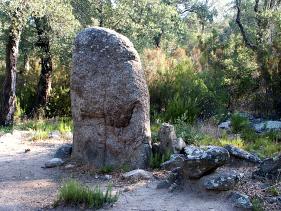
On excursions we often encounter signs that indicate a Dolmen or Menhir is nearby. Next time, take the hint and enjoy a unique voyage of discovery into prehistoric times. Embedded in the most beautiful secluded mountain landscapes are stone graves and cult places from the New Stone Age. They date back up to 7000 years into a time when hunters and collectors settled here in small groups and constructed these grave and maybe cult memorials from gigantic stones. Giant stone plates were raised vertical and served as sort of columns for a larger flat deck plates. These dolmens represent the peak of the megalithic culture. Most are so-called corridor or gallery graves. In that several people were buried, often also chronologically behind each other. Other graves indicate only a single burial, probably for an important person. One name mentioned is Cista, an individual grave of stones.
The Menhirs on the other hand are stones set upright amongst the landscape. The term “Menhir” is derived from the Breton: stone men + and hir = long. Menhirs can either stand alone or be place in groups in rows or in circles. They were social centres and culture installations. And similarly they are often found, as are dolmens, at strategic or regionally interesting points.
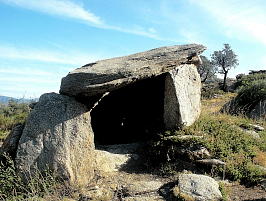
The megalithic culture derives its name from the Greek: mègas = large and lithos = stone. It was widespread, mainly in the northern and western Europe with early reports here in the Mediterranean Sea shore and also in Brittany . The tradition of the megalith design could arise, however, only at places where such big stones were available and could also be transported with the available means of the time. There was seemingly a simultaneous culture cropping up, but probably with similar common belief s and knowledge. – maybe the hope for a life after death. This can be concluded from the finds from grave additions as chains, slates, jewellery and ceramic shells. The findings from our region are mostly found in the archaeological museum of Barcelona .
The megalithic culture dates back into the Bronze Age. The last reports were found on Sardinia and are from the time 800 years before Christ. Many of the megaliths in Europe were destroyed over time – they were eliminated during industrialisation, through land redistributions and land development. But even in the early Middle Ages he megaliths religious motives were judged to be evil. Some believed that they were created by the devil. Some names still show this concern. It is believed that only about 5% of the originally tombs and cult sites are still available to visit.
In the Albera Mountains an especially high concentration of these prehistoric relics are still present. These range for approximately 25 km in west-east direction into the Mediterranean Sea . The wonderful secluded wandering fields lies embedded between the peaks of the Puig Neulós (1.257m), the Puig dels Pastors (1167m) and of the Puig Jorda (753 m). The Albera Mountains were always an important travelling and settlement area for Stone Age people, and many later groups, because of the proximity to the sea and because of the relatively low mountain passes to cross the natural barrier of the Pyrenees .
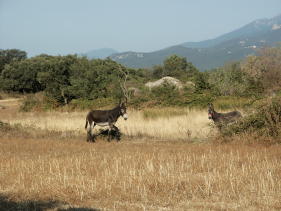
In addition, we are lucky for the local interest in the protection of the national parks and our natural patronage. Otherwise more would have disappeared. The Serra de Albera area was declared a nature park in 1986. Despite its proximity to the tourist centres of the coast one is more likely to encounter a herd of cows or a donkey, then a human, while walking through the park.
In the areas of Roussillon on French side and in the Alt Empordá one can find 112 dolmens, 19 menhirs, 7 Cistes with tumulus, 378 rocks with engravings, as well as 2 Neolithic villages. And, the excavations continue to find more. Presumably it is to the virginity of the secluded landscapes along the Albera-mountains, the Serra de Rodes and the Cap de Creus that allow us to find so much evidence of prehistoric culture here. These areas are now all declared nature parks so nothing will prevent the further discovery of these monuments.
About 50% of the dolmens are in higher mountain situations, and a visit requires some athletic skills and spirit. Other can be found on the plain, and a visit is easier.
The New Stone Age journey begins at the La Jonquera border area and continues over the country in the direction of sea, where the small towns Capmany, Sant Climent Sescebes, Espolla, Rabós, Garriguella, Vilajuiga, Pau, Palau-Saverdera lead to the tourist centre of Roses. Any point is a good starting point for an excursion to see dolmens and menhirs. One very useful book* that describes many worthwhile unique excursions in the Albera mountains is bilingual in both French and Catalan.
Two of these excursions are offered as examples: they offer contemplativeness and lead us through charming landscapes which were far wetter and more wooded then they are now.
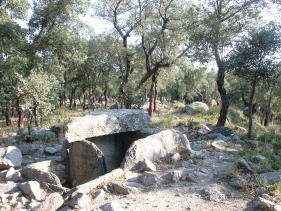
The first goes out of Capmany to the dolmens and menhirs “dels Estanys” (Ponds).
On the way one encounters 9 dolmens, 4 menhirs and a rock drawing, the “Pedra dels Sacrificis”, all within a short distance. The excursion leads through wonderful cork oak fields, lined from tremendous round rocks, into a spiritual landscape. The two ponds can only be recognised by the reed landscape in summer. The silence and the loneliness of the varied landscape inspire flights of fantasy, to roam into the past. The excursion is an easy one, for everyone to enjoy.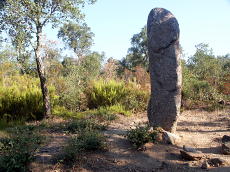
The second excursion leads us through the village Vilajuiga in the direction of the street to St. Pere de Rodes. Soon you will come to a dolman sign on the right side. One can still do a part of the distance by car, and then continue on foot, always upwards, following the yellow marks.
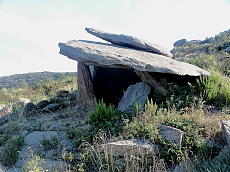
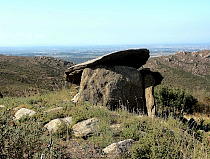
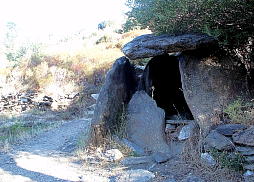
The discovery and reconstruction of the prehistoric monuments continues and our voyage of discovery to the dolmens and menhirs will also continue, maybe in the spring and autumn when it is dry, and not so hot. In this unchanged nature with its unique flora and fauna our fantasy travels far back to our ancestors in the Stone Age and prompts many questions.
How did they raise these massive giant stone plates? Who are buried within? What were the burial rituals? What did the region look like when it was wetter and more with dark forests? How did these people live?
Regardless of whether you are in Llançà, Port de la Selva, Cadaqués or Roses there are dolmens nearby. The tourism offices all have extensive information material for your next excursion. For example Llançà offers “Ruta Megalitica i Preromanica” which offers a map to a number of long-ago sites including dolmens and a menhir.
* L’Albera, Les Albères, ISBN: 2-9515352
[cetsEmbedGmap src=http://maps.google.es/maps?f=q&source=s_q&hl=es&geocode=&q=L%27albera,+Capmany,+Girona&sll=39.96028,-3.713379&sspn=7.981087,14.128418&ie=UTF8&hq=L%27albera,&hnear=Capmany,+Gerona,+Catalu%C3%B1a&ll=42.431566,3.013&spn=0.240224,0.441513&t=p&z=11 width=350 height=425 marginwidth=0 marginheight=0 frameborder=0 scrolling=no]

The dolmens and other megaliths (pyramids, cromlechs, and others) were built for defense. Read more http://forum.ozersk.ru/topic/32337-raskritie-tain-drevnosti/